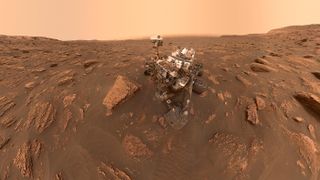
NASA would be thrilled if its newly launched Mars rover ended up matching its predecessor's longevity.
The agency's car-sized Curiosity rover celebrates eight (Earth) years on the Red Planet today (Aug. 5), less than a week after the Perseverance rover took flight toward Mars.
The synergy in timing is appropriate; Perseverance shares Curiosity's chassis and "sky crane" landing strategy, among other features. And the new rover will build upon the many discoveries that Curiosity has made over the years.
Related: Amazing Mars photos by NASA's Curiosity rover (latest images)
Curiosity launched in November 2011 and touched down inside the 96-mile-wide (154 kilometers) Gale Crater on the night of Aug. 5, 2012, kicking off a surface mission designed to last at least one Martian year (which is equivalent to 687 Earth days).
The main goal of Curiosity's $2.5 billion mission, officially known as Mars Science Laboratory, involves assessing whether Gale could ever have supported Earth-like life. The nuclear-powered robot has returned exciting news on this front, finding that the crater hosted a potentially habitable lake-and-stream system for long stretches in the ancient past, perhaps millions of years at a time.
Curiosity has also detected complex organic chemicals, the building blocks of life as know it, in Gale Crater rocks. In addition, the rover has rolled through several plumes of methane and discovered a seasonal pattern in the concentration of this gas, which here on Earth is primarily produced by living organisms. (Abiotic processes can generate methane as well, however, and the source of the stuff within Gale is unclear.)
Get the Space.com Newsletter
Breaking space news, the latest updates on rocket launches, skywatching events and more!
In September 2014, Curiosity reached the base of Mount Sharp, which rises 3.4 miles (5.5 kilometers) into the sky from Gale's center. For the past six years, the rover has been climbing through the mountain's foothills, reading the rocks for clues about Gale's past habitable environments and how Mars transitioned into the cold, dry desert planet we know today.
During its eight years on Mars, Curiosity has drilled 27 rock samples, scooped up six soil samples and put more than 14 miles (23 km) on its odometer, NASA officials said. (The Mars surface-distance record is held by another NASA rover, Opportunity, which covered 28.06 miles, or 45.16 km, between 2004 and 2018.)
Perseverance's $2.7 billion mission, called Mars 2020, aims to extend Curiosity's findings. The new rover will hunt for signs of ancient life in Mars' 28-mile-wide (45 km) Jezero Crater, which was home to a lake and a river delta long ago.
Perseverance will also collect and cache samples for future return to Earth and test out several new exploration technologies, including a tiny helicopter named Ingenuity and an instrument that generates oxygen from the thin, carbon dioxide-dominated Martian atmosphere.
Mars 2020 is scheduled to touch down on Feb. 18, 2021. Maybe Curiosity will take a short break from its work in Gale Crater that day, look up at the Martian sky, and send well wishes to the new arrival.
Mike Wall is the author of "Out There" (Grand Central Publishing, 2018; illustrated by Karl Tate), a book about the search for alien life. Follow him on Twitter @michaeldwall. Follow us on Twitter @Spacedotcom or Facebook.
Join our Space Forums to keep talking space on the latest missions, night sky and more! And if you have a news tip, correction or comment, let us know at: community@space.com.

Michael Wall is a Senior Space Writer with Space.com and joined the team in 2010. He primarily covers exoplanets, spaceflight and military space, but has been known to dabble in the space art beat. His book about the search for alien life, "Out There," was published on Nov. 13, 2018. Before becoming a science writer, Michael worked as a herpetologist and wildlife biologist. He has a Ph.D. in evolutionary biology from the University of Sydney, Australia, a bachelor's degree from the University of Arizona, and a graduate certificate in science writing from the University of California, Santa Cruz. To find out what his latest project is, you can follow Michael on Twitter.
-
rod The space.com report noted "During its eight years on Mars, Curiosity has drilled 27 rock samples, scooped up six soil samples and put more than 14 miles (23 km) on its odometer, NASA officials said. (The Mars surface-distance record is held by another NASA rover, Opportunity, which covered 28.06 miles, or 45.16 km, between 2004 and 2018.)"Reply
This report shows what took place with Opportunity and it died on the surface of Mars during 2018 Mars opposition, a global dust storm. https://skyandtelescope.org/astronomy-news/rover-call-home-nasa-opportunity/
Curiosity is nuclear power, Opportunity died, it was solar powered. Curiosity survived the Martian dust storm.